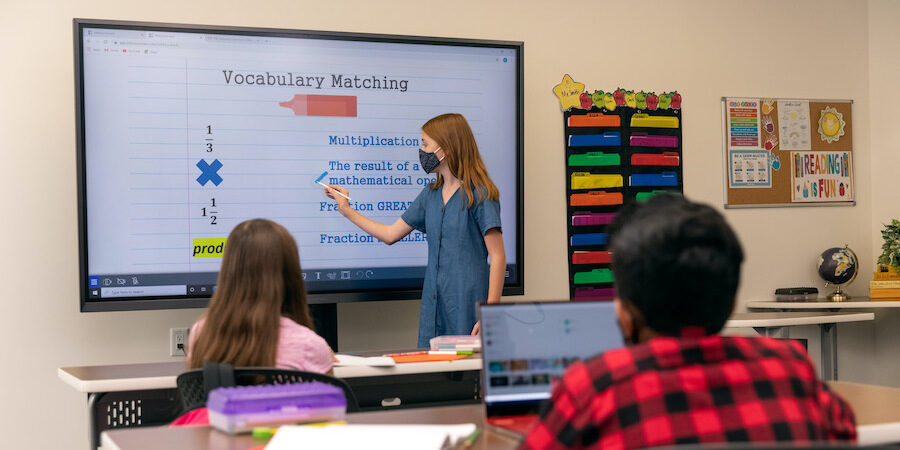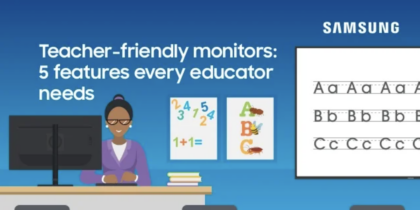While classrooms are beginning to fill up with students again, blended and hybrid learning models won’t disappear. Some students will continue to go to school remotely because it meets their needs and allows them to thrive.
As educators gain more experience with hybrid and fully remote learning models, they’re optimizing classroom technology to meet their students’ needs. Teachers must have creative ways to actively engage their remote students, going beyond asynchronous teaching that simply sends recorded lessons to students’ home devices to watch on their own time. With collaborative technology tools, teachers can facilitate synchronous classroom discussion and sharing, compensating for the socially distanced setup of hybrid learning environments.
These digital classroom solutions are tailored to the needs of educators, students and parents alike.
Beyond video calls
Effective hybrid learning plans go far beyond moving assignments and lessons online and getting accustomed to video calls. Forward-thinking hybrid classrooms make technology central to teachers’ day-to-day instruction and students’ collaboration. Digital classroom solutions are tailored to the needs of educators, students and parents alike.
Create a hybrid learning environment
Learn how to use interactive digital signage to increase student collaboration in hybrid classrooms. Download Now
The new generation of interactive digital whiteboards takes a smart classroom approach. With enhanced connectivity and collaboration tools, these displays make it easier for students and teachers to communicate — both in person and online.
While video calls are bridging the physical gap, such interaction can only provide so many benefits. In-class whiteboards or video kits that can be accessed remotely — and in real time — by students create an immersive experience for at-home students that’s more akin to the classroom. With these tools, schools can begin to change the digital landscape for the betterment of their student body.
Do-it-all displays
While technology has enhanced the in-class learning experience over the last 20 years, all too often teachers have been tasked with using multiple devices for a variety of uses. New technology brings more solutions together in a single place.
A large interactive display — equipped with the tools needed for instant collaboration — can be the centerpiece of a learning environment. Notes are easily shared across remote laptops, desktop PCs, smartphones or tablets, allowing remote students to actively collaborate with their classmates. Content can also be saved and archived on the display, so students learning remotely may receive full recaps — including visuals and annotations — via email.
For students brainstorming in person, Samsung’s new Interactive Display can interpret up to 20 simultaneous touch points. The display includes a built-in document viewer — allowing students to work on files they usually view on their computers or mobile devices — as well as image editing and painting tools.
All-in-one solutions
Solution providers are now collaborating to bring best-in-class education tools into instruction. For example, Boxlight Corporation, whose MimioConnect platform integrates seamlessly with educational displays, can be used to connect in-class and at-home learners.
In blended and hybrid learning environments, MimioConnect enables:
- Real-time collaboration between teachers and students on the same document, regardless of location
- Assignments that can be pushed to students in the classroom or at home with a single click
- Engaging remote learning tools, such as polls and interactive questions
- Analytics on student understanding, using assignment data including students’ scores and time spent on tasks
Seeing and hearing
To create an effective hybrid learning environment, educators have to ensure that the tools they’re using are good at what they do. The video quality needs to be stable and sharp, the audio crisp and clear.
Samsung has partnered with networking provider Cisco to create hybrid learning solutions built on the Cisco Webex Room Kit. The setup uses sophisticated, 4K-capable wide-angle cameras that can capture the full classroom and track the teacher. The video is paired with high-quality audio from built-in microphones and speakers. Bundled with interactive displays from Samsung, the Cisco Room Kit enables features like multiple side-by-side windows (e.g., lesson material next to a livestream of the teacher or presenter).
In a remote setting, students can also benefit from webcam monitors, which have a built-in camera and speakers that make it significantly easier for them to learn at home and feel a part of the classroom setting.
Low learning curve
Also key to effective hybrid learning plans is maintaining a low learning curve so that educators and students don’t feel overwhelmed by their new classroom technology.
Interactive whiteboards are designed to be highly intuitive — a tool that users can walk up to and use without any training. Mimio is designed for minimal-click simplicity, and the technology partner tools are intended to be plug-and-play. Students can stay focused on learning the subject matter, not on how to use the tools.
Until schools reopen their doors for fully in-person learning, teachers and students should take full advantage of all that remote learning has to offer. As you look for ways to enhance your digital classroom, consider Samsung’s toolkit for learning from home. Or, read our free white paper on how to make learning more fun with interactive technology








